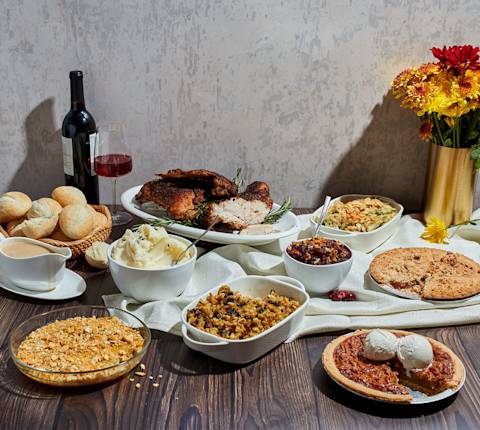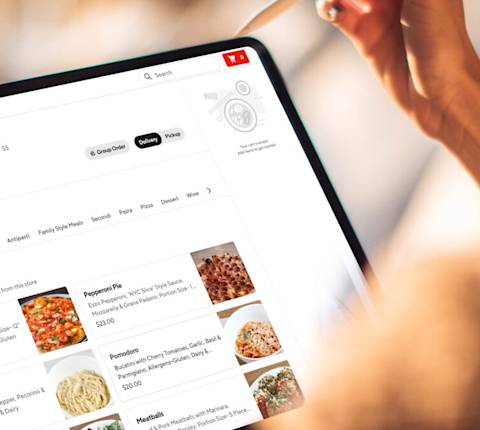Why is a great restaurant front page so important?
It's no secret that your restaurant's online presence matters. 35% of consumers say a restaurant's website influences their decision to try a new restaurant for delivery or takeout. In other words, you'd better believe prospective patrons are looking up menus, photos, and reviews before they order delivery or visit.
But these days, simply building a restaurant website isn't enough. User experience also matters, as 85% of customers say it's important to be able to easily find restaurant information and reviews online.
12 tips for building a restaurant website
So, what are the top website design tips that enable restaurants to reach their full potential? Here are 12 strategies for your restaurant front page.
1. Clearly share basic business information
When customers visit your restaurant's website, they're typically looking for a few basic pieces of information, like your location, phone number, operating hours, and how to make reservations. Omitting these key details can leave diners wondering — and they may simply go somewhere else rather than spend time searching for answers.
After adding these details to your site, check that they're clear and easy to find. "About Us" or "Contact" pages are universally recognized by site visitors as places where this information usually lives.
2. Build a restaurant website that is mobile-friendly
We do everything from our phones these days, and ordering food is no exception. In 2022, 71% of consumers placed a restaurant order from a mobile device — so having a mobile-friendly restaurant website is key to success.
If you've built a good restaurant website for desktop browsers, but it doesn't provide a good user experience on smartphones or tablets, check if your website builder has an editing feature for mobile design. If not, consider switching to a platform like Squarespace, which has built-in responsive mobile design features to ensure your website looks appealing on any device.
3. Ensure text is easy to read
Another common restaurant website mistake? Overdoing it on copy. The last thing hungry customers want to do is read lengthy paragraphs of text after navigating to your website. Stick to simple, concise copy that conveys exactly what customers need to know and nothing more. Do you serve Spanish tapas with a modern twist? Grain bowls for health-conscious customers? Make your message clear but succinct. In addition to the text on your web pages, keep your menu descriptions compelling yet brief as well.
While you're revamping your copy, consider whether the text is legible against your website's background or in its current font size. Customers may be turned off trying to decipher hard-to-read text.

4. Invest in professional food photography
You know the saying: a picture is worth a thousand words. According to an MGH survey of TikTok users, 53% of Millennials and 38% across all generations have ordered or visited a restaurant after seeing it on the social media platform, with "appetizing-looking food" as the driving force behind their willingness to visit. Harsh lighting, unflattering angles, and grainy resolutions are just a few common culprits of lackluster food photos. If your website photos don't do your food justice, customers may never make it through your doors to find out how delicious those dishes truly are.
But are you wondering how to take your own amazing menu photos for your restaurant website? If you can, borrow a high-quality camera and shoot in the morning or late afternoon when natural lighting is best. Keep the background simple so your dishes can really shine. Not feeling confident in your photography skills? DoorDash partners are eligible for a free professional photoshoot to bring their menu photography to the next level.

5. Pay attention to search engine optimization (SEO)
When choosing where to order takeout food from, 13% of customers use an online search engine. But a beautiful website won't be very useful if customers can't find it in the first place. Making efforts to boost SEO will help ensure that your website appears among the top results when customers look for restaurants, cuisines, or dishes in their area. For instance, if you want to cater to the many diners searching "vegetarian restaurants in Orlando," include that keyword phrase throughout your website.
Tools like Google Analytics can help you understand how many visitors your site receives, what time of day they're coming, and which keywords are driving your web traffic. With these insights, you can double down on the phrases or descriptions that are hooking prospective customers in search results. Optimizing your Google Maps and Google My Business listings is another important SEO strategy, since it serves as a sort of homepage for local consumers to learn more about your business, cuisine, reviews, and location.
6. Add an email signup form
Building a restaurant website that attracts visitors is a great first step — but it's even better to capture their information and stay top of mind by sending enticing offers straight to their inboxes. If you don't have a form where customers can subscribe for news about your restaurant's special events and promotions, you're missing an opportunity to turn one-time visitors into loyal regulars. Adding a simple pop-up window or banner for your sign-up form — or giving customers the chance to opt in to email updates when placing their order — will help you organically grow your following.
7. Create a webpage for your food menu
One of the most common restaurant website mistakes is uploading your menu as a PDF. PDF menus might be convenient to make and keep up to date, but they also sabotage your online visibility over the long run. A good restaurant website includes a webpage for the menu, as most search engines easily crawl HTML and prioritize website pages over PDFs. So when customers search for specific dishes in their area — like fish tacos, chicken noodle soup, or lobster rolls — they're more likely to see web-based menus in search results instead of your PDF.
8. Write clear menu descriptions
Once your restaurant's website menu is SEO-friendly, it's time to make sure the menu itself realizes its full potential. Do the menu descriptions paint a vivid, appealing picture of each dish — and are you giving customers enough information about the ingredients and where they came from? Think of menu descriptions as a way to lure diners in. By providing ample details about your dishes, you can also help people with dietary restrictions or food allergies feel comfortable eating at your establishment.
When writing menu descriptions, be sure to list every dish's main ingredients, accompaniments, and key preparation details — along with a few sensory words. For more tips about building an effective restaurant menu, check out our guide to writing compelling food descriptions.
9. Use a modern website builder
Adobe Flash Player was once a good restaurant website builder, but those days have come and gone. In addition to no longer being supported by Adobe (or major web browsers like Google Chrome, Microsoft Edge, Mozilla Firefox, and Apple Safari for that matter), Flash can't be crawled by search engines and has a number of security issues. At the end of the day, if you're building a restaurant website on Flash, your SEO and overall online presence will suffer — and customers will have a hard time finding you.
10. Ensure all information on the restaurant front page is up to date
There's nothing more confusing and frustrating than a restaurant website filled with outdated information, especially when the information conflicts with details shared by other online sources. Incorrect hours, a broken telephone line, or last season's menu are all red flags that can be easily avoided. Simply scheduling a regular time (e.g. once a month) to make sure your website is up to date will save a lot of headaches for potential diners.
11. Include positive press and customer reviews
According to a survey by Yelp, 67% of people "heavily researched" their dining options on review sites before deciding where to eat. Highlighting positive reviews right on your restaurant's website can be the extra nudge potential customers need to place an order.
Feature glowing comments in a sidebar on your website, or create a simple graphic to show how many stars you've received on Yelp or Google Reviews. Did a news article praise you for having the best pizza in Portland? Don't forget to include it somewhere on your site to elevate visitor trust.
12. Add a button for online ordering
You want to make sure your customers' online ordering experience is seamless. And here's the good news: you don't have to be a software engineer to create an online ordering website for your restaurant. DoorDash Online Ordering allows you to easily add delivery and pickup ordering to your own website. Simply sign up, add your menu, and customize it to match your restaurant's branding. It only takes a few minutes to set up your Online Ordering page — and, best of all, orders are commission-free.

A well-designed restaurant website is key to success
The bottom line for restaurants? There's no better time for building a restaurant website and setting up an online ordering platform to turn prospects into paying customers. Download our restaurant website marketing guide for more key tips — and consider using Online Ordering to add commission-free online ordering to your website. Ready to chat with the team? Sign up for a demo of Online Ordering today.





